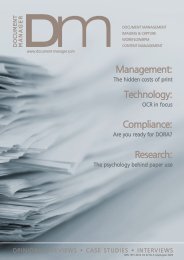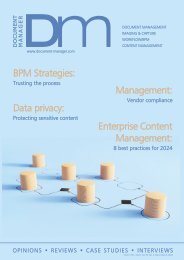CS Nov-Dec 2022
You also want an ePaper? Increase the reach of your titles
YUMPU automatically turns print PDFs into web optimized ePapers that Google loves.
ansomware<br />
Dan Turner, Forcepoint: cybersecurity<br />
professionals in CNI work in a climate<br />
of high risk and diverse threats.<br />
Daniel Hofmann, Hornetsecurity: attacks<br />
on businesses are increasing, yet there's a<br />
shocking lack of awareness and preparation<br />
by IT pros.<br />
increases the difficulty of mitigating or<br />
controlling the impact of an attack. In the US,<br />
the greatest concern was of a power outage,<br />
whereas cybersecurity professionals in the<br />
UK predict that disruption to personal<br />
banking would have the greatest impact."<br />
The threat of disruption is also amplified<br />
by what cybersecurity professionals believe<br />
motivates cyberattacks on CNI. The greatest<br />
threats were perceived to be from cyber<br />
gangs demonstrating their capabilities, acts<br />
of political retaliation, acts of hacktivism and<br />
acts of cyber warfare.<br />
"Unfortunately, the research has also found<br />
many CNI cybersecurity professionals are<br />
feeling the pressure of this high-pressure,<br />
high-complexity environment. Feelings of<br />
stress, anxiety and burnout are affecting over<br />
one-third of all CNI cybersecurity professionals<br />
[35%, 39% and 36% respectively]. "This is<br />
impacting their professional experience,<br />
with two-fifths of cybersecurity professionals<br />
reporting that the pressure to secure CNI<br />
has led them to have a low morale at work<br />
(40%), rising to 51% of UK employees.<br />
Worryingly, it is also affecting their personal<br />
well-being."<br />
Adds Dan Turner, vice president at<br />
Forcepoint: ""Understanding the challenges<br />
our cybersecurity professionals in CNI are<br />
facing helps us find better solutions to<br />
alleviate the burden on them. They work in<br />
a climate of high risk, diverse threats when<br />
rapid adoption of new technologies changes<br />
security parameters all the time. Knowing<br />
what motivates and worries our industry is<br />
key - it helps us help them in their efforts to<br />
ensure no new threat or technology puts<br />
our essential services at risk of disruption,<br />
so which, in turn, allows us to secure a safer<br />
and more sustainable future for everyone."<br />
BIGGEST CHALLENGES TO OVERCOME<br />
"Securing an expanding digital footprint<br />
is one of the biggest challenges facing<br />
companies," points out Sam Curry, chief<br />
security officer, Cybereason. "With ransomware<br />
attacks surging, the clock starts to<br />
immediately tick after ransomware has<br />
executed. And when the ransom itself is<br />
received, that is a time of high adrenaline,<br />
confusion and panic for most. This is actually<br />
by design on the part of the attackers.<br />
They attack, often, at night, on holidays<br />
and weekends to maximise pressure, and,<br />
therefore, the chance of poor decisionmaking<br />
and capitulation. According to a<br />
recent Cybereason study on ransomware<br />
attacks, more than 60% of organisations<br />
lack preparedness on holiday and weekends,<br />
and it limits their ability not only to assess<br />
the risk, but stop it as well. Hackers know<br />
this and they attack accordingly.<br />
"Companies can't pay their way out of<br />
ransomware and many decide they won't<br />
pay," adds Curry. "Hopefully, they are backing<br />
up data, but how quickly can the data be<br />
operational? If a company isn't backing up<br />
their data and still won't pay, that decision<br />
comes with weathering the pain of rebuilding.<br />
And what other trade-offs come into<br />
play? Can services continue? Is public safety<br />
or human life at risk? What is the cost of<br />
rebuilding? How long will it take to rebuild<br />
etc? There is the arithmetic of recovery, the<br />
risk equation, the truly compelling questions<br />
like not putting human life at risk and then<br />
there is also the ethical question of funding<br />
criminal activity."<br />
TICKING TIMEBOMB<br />
Given the massive strides that the security<br />
industry has been making in developing<br />
sophisticated network protection technology,<br />
this raises a vital question according to Mark<br />
Oakton, CEO/Consulting CISO, Infosec<br />
Partners: "Why is ransomware still able<br />
to keep CISOs awake at night and send<br />
shockwaves through the corporate world's<br />
boardrooms?" There are many reasons, he<br />
believes, including a reliance on outdated<br />
technology, combined with poor staff<br />
awareness and training - but ultimately the<br />
answer lies in human nature. "Ransomware<br />
attacks are typically the result of a simple<br />
26<br />
computing security <strong>Nov</strong>/<strong>Dec</strong> <strong>2022</strong> @<strong>CS</strong>MagAndAwards www.computingsecurity.co.uk

















